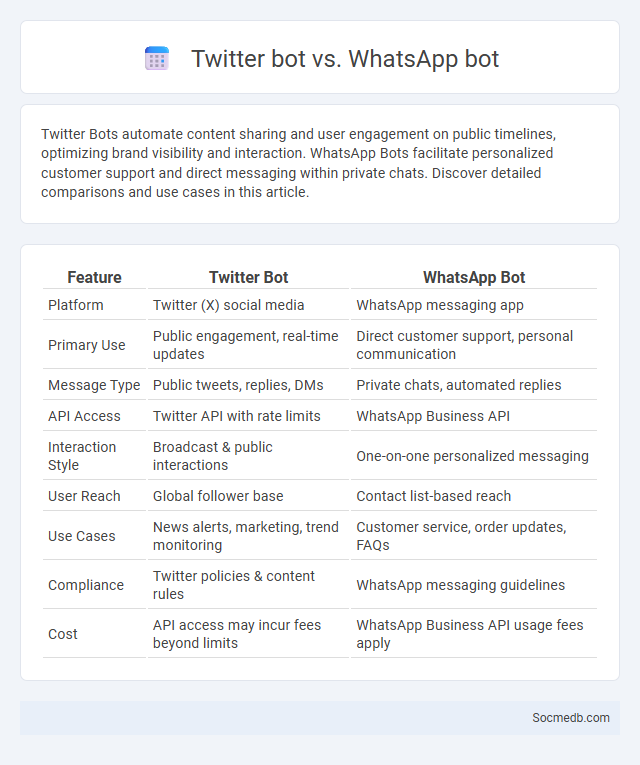
Photo illustration: Twitter Bot vs WhatsApp Bot
Twitter Bots automate content sharing and user engagement on public timelines, optimizing brand visibility and interaction. WhatsApp Bots facilitate personalized customer support and direct messaging within private chats. Discover detailed comparisons and use cases in this article.
Table of Comparison
| Feature | Twitter Bot | WhatsApp Bot |
|---|---|---|
| Platform | Twitter (X) social media | WhatsApp messaging app |
| Primary Use | Public engagement, real-time updates | Direct customer support, personal communication |
| Message Type | Public tweets, replies, DMs | Private chats, automated replies |
| API Access | Twitter API with rate limits | WhatsApp Business API |
| Interaction Style | Broadcast & public interactions | One-on-one personalized messaging |
| User Reach | Global follower base | Contact list-based reach |
| Use Cases | News alerts, marketing, trend monitoring | Customer service, order updates, FAQs |
| Compliance | Twitter policies & content rules | WhatsApp messaging guidelines |
| Cost | API access may incur fees beyond limits | WhatsApp Business API usage fees apply |
Introduction to Bots: Twitter, WhatsApp, and General Bots
Bots on social media platforms like Twitter and WhatsApp automate interactions, enabling efficient content sharing, customer service, and real-time updates. Twitter bots can post tweets, retweet, and engage with users to amplify messages or trends, while WhatsApp bots facilitate automated responses, appointment scheduling, and transactional messages in private chats or groups. General bots leverage natural language processing and machine learning to simulate human conversation, enhancing engagement and providing personalized user experiences across various digital channels.
Key Features of Twitter Bots
Twitter bots automate posting, following, and liking activities to increase engagement and streamline social media management. They utilize natural language processing and machine learning algorithms to generate contextually relevant content and respond to user interactions effectively. Integration with APIs allows these bots to monitor trends, gather analytics, and perform targeted outreach based on user behavior and keywords.
Capabilities and Use Cases of WhatsApp Bots
WhatsApp bots leverage AI-driven automation to provide instant customer service, order tracking, and personalized notifications, enhancing user engagement on the platform. These bots enable businesses to conduct seamless transactions, schedule appointments, and deliver tailored marketing campaigns directly within WhatsApp's secure environment. Their integration with CRM systems and payment gateways streamlines communication workflows and boosts operational efficiency.
General Bots: Versatility Across Platforms
General bots demonstrate exceptional versatility across social media platforms by automating tasks such as content posting, audience engagement, and data analysis. These AI-powered tools adapt to diverse environments like Instagram, Twitter, and Facebook, optimizing user interaction and streamlining marketing efforts. Their cross-platform functionality enhances efficiency, driving growth and consistent brand presence.
Platform Integration: Twitter vs WhatsApp vs Other Bots
Twitter offers robust platform integration through its API, enabling real-time data sharing and seamless interaction with various bots for automated replies and content curation. WhatsApp focuses on direct, encrypted messaging with business API support, facilitating personalized customer service bots and interactive chat experiences within a secure environment. Other bots on platforms like Facebook Messenger and Telegram provide diverse integration options, including multimedia sharing, advanced AI-driven interactions, and cross-platform connectivity to enhance user engagement.
User Interaction and Engagement Differences
User interaction on social media varies significantly across platforms, with visual-centric networks like Instagram and TikTok driving higher engagement through short-form video and image content. In contrast, platforms such as Twitter and LinkedIn emphasize text-based communication, fostering more direct conversations and professional networking. Engagement metrics including likes, shares, comments, and time spent per post differ due to each platform's unique algorithm, audience demographics, and content format.
Security and Privacy Considerations
Protecting your social media accounts requires strong, unique passwords and enabling two-factor authentication to prevent unauthorized access. Regularly reviewing privacy settings helps control who can view your posts and personal information, reducing the risk of data breaches. Be cautious about sharing sensitive details and avoid clicking on suspicious links to maintain your online security and privacy.
Development and Deployment Complexity
Social media platforms require sophisticated development frameworks that integrate APIs, real-time data processing, and scalable cloud infrastructures to handle millions of concurrent users. The deployment complexity involves continuous integration and delivery pipelines, robust security protocols, and compliance with data privacy regulations like GDPR and CCPA. Optimizing Your social media application necessitates managing these technical challenges to ensure seamless user experience and rapid feature updates.
Real-World Examples and Success Stories
Brands like Nike leverage Instagram's visual storytelling to drive engagement and sales, achieving a 15% increase in online revenue within six months. Wendy's Twitter account is renowned for witty customer interactions, boosting follower growth by over 40% annually and enhancing brand loyalty. TikTok campaigns by e.l.f. Cosmetics generated millions of user-generated videos, resulting in a 110% increase in brand impressions and substantial conversion rates.
Choosing the Right Bot for Your Business Needs
Selecting the right social media bot involves analyzing your business goals, audience engagement levels, and automation requirements. Your ideal bot should offer features such as personalized messaging, multi-platform support, and real-time analytics to optimize interactions and boost customer satisfaction. Investing in a bot tailored to your specific needs enhances efficiency, drives growth, and strengthens your online presence.
 socmedb.com
socmedb.com